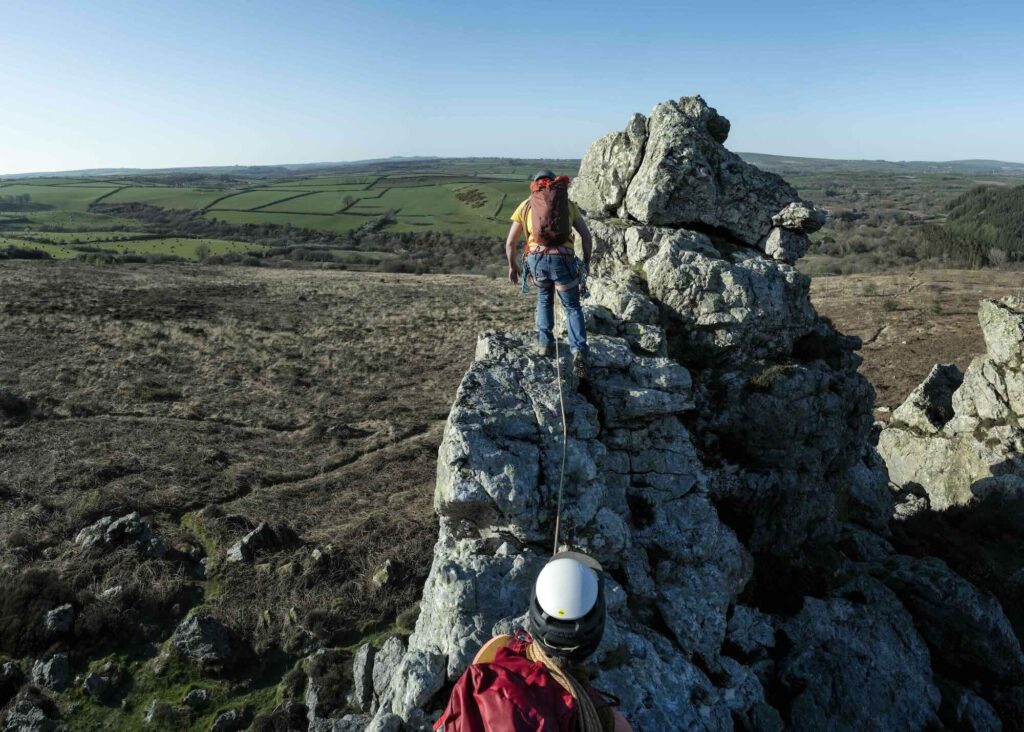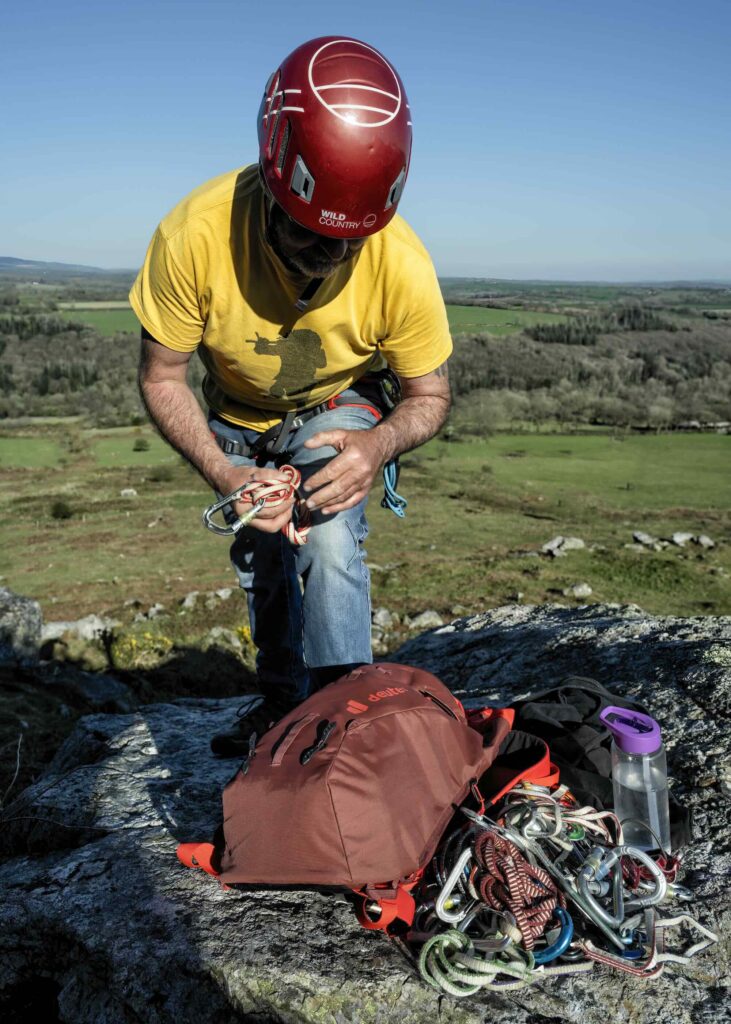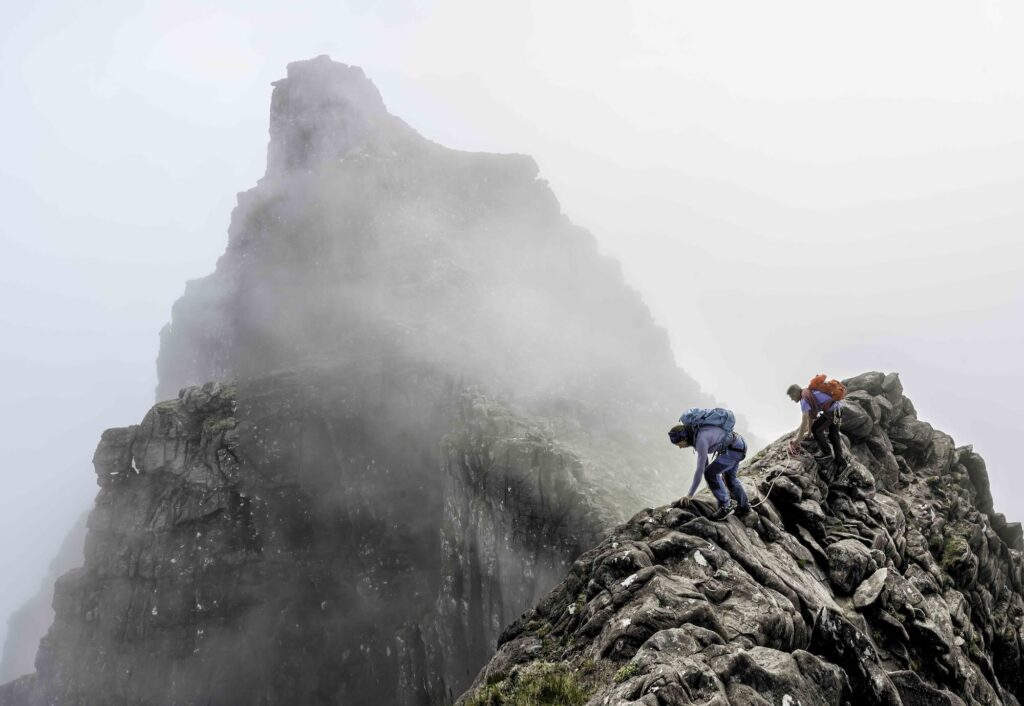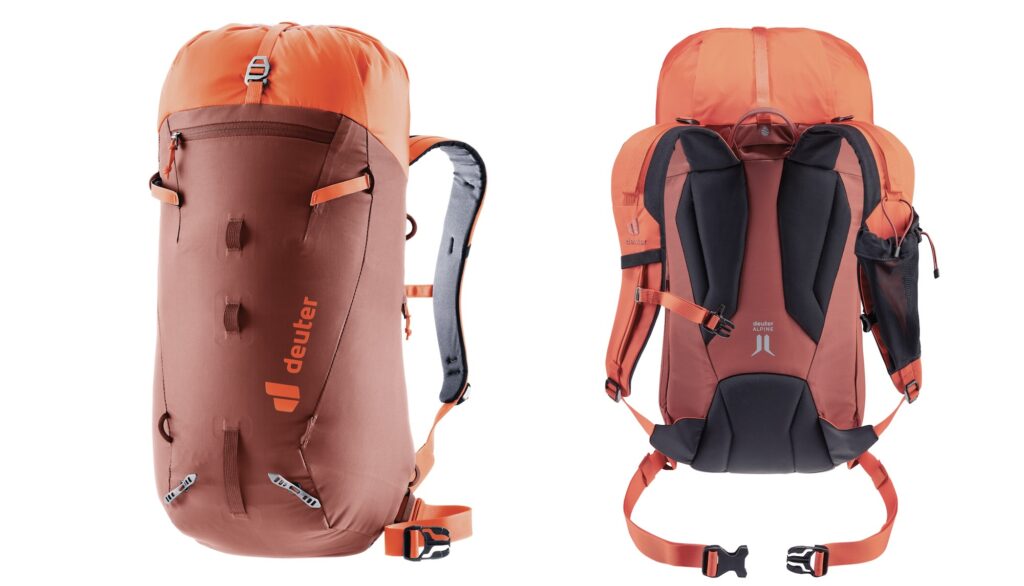In the first of a 2-part series, in association with deuter, Alun Richardson advises on the essential knowledge you need to start scrambling…
At the top of the Chasm Face, a classic grade 3 scramble on Glyder Fach in North Wales, I stepped towards the edge and looked down the line of our ascent. The steep drop left me with a question – was it a scramble or a rock climb? I would like to say that the answer was straightforward, but unfortunately there is no simple answer. One person’s scramble is another person’s rock climb, and it is that subjective view that makes scrambling such a wonderful pastime. There are not many sports that you can choose the size of the pitch and the size of the opposition to suit your experience, your mood and, of course, the weather?
What is scrambling?
‘Scrambling’ is an ambiguous noun and verb that attempts to describe the gap between mountain walking and rock climbing. It’s a bit like a healthy diet – most of us know what it is, but trying to explain it proves very difficult. Scrambling has existed since people started exploring the hills, and early scrambles were done by botanists and explorers. In 1802 Coleridge descended Broad Stand in the Lake District and in 1826 John Atkinson, an Ennerdale shepherd, climbed Old West route on Pillar Rock. Even the father of British rock climbing, Walter Parry Haskett-Smith, thought that rock climbing using a rope was wrong: “We were rather heretical in our attitude to the use of the rope not having one ourselves. In the gall of bitterness, we classed ropes with spikes and boulders, as a means by which bad climbers could go where none but the best climbers ought to be”.

On harder scrambling routes, a rope is used to keep participants safe
At one end of the spectrum scrambling describes routes that adventurous walkers ascend such as Crib Goch on Snowdon and Striding Edge on Helvellyn. At the other end of the difficulty scale, routes like Broad Stand on Scafell and the Parson’s Nose on Crib Y Ddysgl are, in reality, easy rock climbs. Some of the classic ridges of the UK such as the Cuillin Ridge encompass all types and standards of scrambling.
For me, the joy of scrambling is that it takes me away from well-trodden paths and onto secluded buttresses and ridges where far fewer feet have travelled. But that brings its own problems, not least that the very places I am seeking solitude and adventure in are often the last sanctuaries for rare plants and animals tenuously hanging onto their grip on survival. We must all therefore give great thought to every footstep when we are scrambling to ensure we leave the delicate plant life untouched.

There are great scrambling routes to be found all around the UK
Scrambling grades
There are guidebooks to scrambles all over the world, each enticing you to take a slightly more exciting and rocky route up mountains. However, as we’ve insinuated above, selecting a scramble to suit your ability and experience is a bit of a black art. In the UK, scrambling is broken down into four grades (sort of), with the grade being based around technical difficulty and exposure. There is a big difference between a grade one and a four. Some older Scottish guidebooks used a system of grades 1 to 5, leading to considerable confusion over grades 1, 2 and 3. The grade alone is not enough, however – one must also consider the weather conditions which can easily change the grade. On the continent, some authors describe them as easy, moderate or difficult. The important thing to realise is that the more difficult the scramble, the more like rock climbing it becomes.
Grade 1 – The terrain may have some big drops, but is technically easy. Ropes are only required by the nervous walker and you may be able to circumvent the difficulties. There may be the occasional hard step where hands will be required. Route finding is obvious e.g. Crib Goch on Snowdon, or Jack’s Rake on Pavey Ark in the Lake District.
Grade 2 – Will have longer difficult sections where a rope and rock climbing techniques may be needed. Route finding can be difficult, and escape from the route may not be easy e.g. Clogwyn Y Person Arete, Crib Y Ddysgol and Llechog Buttress.
Grade 3 – Lots of tricky sections with many pitches of easy rock climbing. Dry conditions may be essential. Escape is probably by abseiling, and route finding skills are required. Cneifion Arete, Mynydd Mawr and Shark Buttress on Glyder Fach.
Grade 4 – (3S in some books, the ‘S’ means ‘serious’) Exposure will be high and it will feel more like a rock climb; in fact, you may also find the route in a rock climbing guidebook. Escape is by means of an abseil e.g. Cyfrwy Arete on Cadair Idris, and the West Peak via Bilberry Terrace on Lliwedd.
Where to go
Scrambling terrain in the UK is usually found on the mountains of mid/north Wales, the Lake District and Scotland, but they can be found anywhere, even traversing on sea cliffs. This isn’t coasteering, which involves entering the water; sea cliff scrambling focuses on staying above the water, exploring the cliffs themselves and can involve using ropes, helmets and harnesses, but all above the reach of the waves.
Equipment
For scrambling you can carry the usual equipment that you would for summer mountain walking, but as soon as you get above grade 1 then you will need extra thought about what to take.
Footwear: I sometimes wear boots and other times sturdy approach shoes, both with good lateral rigidity in the sole (to test a boot for low lateral twist, grab the heel and toe of the boot and twist in opposite directions). Specialist scrambling boots are great on the rock bits, but often have very poor grip on grassy terrain.
Rucsack: The ideal pack for scrambling is a simple tube design between 25 and 40 litre. I don’t like a rucksack with a plethora of straps or bungee cords because they get caught on the rock, especially as you may have to squeeze through tight spaces. Avoid packs with frames because they put the pack away from your spine and you want your pack to be part of you and move with you, so get one that sits as close and snug as possible. Also make sure that the pack lid doesn’t restrict your movement when you try to look up with a helmet on. Load your pack carefully so that the weight is low and against your back and use the compression straps to keep the load from moving around – this will help you to stay in balance.
Specialist gear: The technical gear above and beyond the kit for summer walk will depend on the grade of the scramble. Each person should have a belay/abseil device, nut key and 120cm sling with a locking carabiner. The group gear you might carry will range from a 30m single rope tied around the waist, a sling and an HMS krab, to a harness, helmet, small rock climbing rack and a 40/50m single rope.

A light, streamlined backpack is ideal for carrying your kit
A typical rack of climbing gear for more technical scrambles is as follows:
- An assorted set of wired protection e.g. DMM Wallnuts
- Two large hexes on wire, or two extra large Wild Country nuts
- Three cams – 0.5, 0.75 and 1
- 4 x 60cm slings
- 4 x 120cm slings with locking carabiners
- 3 x 240cm slings with large locking HMS carabiner
- Two spare locking HMS carabiners
- Belay tube
- Nut key
- Prussik
- Some 7/8mm abseil tat in case of retreat
The art of staying safe
Scrambling is the ultimate test of the ‘what if’ question: What if I slip here? What are the consequences of a fall? Scrambling has been described as ‘climbing a route where hands must be used for balance during the ascent’, and rock climbing as ‘an ascent where your hands hold your body weight’. If we take that definition seriously, then many mid-grade scrambles soon become easy rock climbs. Describing scrambling as ‘easy’ rock climbing belies the fact that it can actually be a more risky activity requiring efficient movement in big boots over exposed and loose terrain, often without a rope. Your partner must understand what is happening and communication is important to let them know where you are not comfortable with the level of risk. An efficient scrambling team is a delight to watch as they choose the appropriate technique at any given moment and fluidly change between options. To do this well they must make judgements, not only about the terrain ahead, but also about both their own ability and their partner’s. It demands the appropriate application of a variety of techniques generally employed in alpine mountaineering and rock climbing.

If you need to use your hands, then chances are you’re scrambling!
Easy scrambling terrain
This can be defined as ground where a rope is generally not required, there may be a lot of grass, you may be in a damp gulley and there will be rocky steps that you are happy to solo because a slip will not mean death! The difficult steps may however require you to ‘spot’ each other. On this type of terrain keep asking yourself what are the consequences of a fall? What is the terrain like ahead? What are you and your partner’s abilities? Are you both stable on your feet? Are you climbers or walkers? Is there more walking after the difficult step or do you need to put a rope on? Do you need to get harnesses out or can you just attach the rope around the waist? Could they end up dangling in space? Once the answer to the ‘what if’ question is that you are getting the rope out, the fluidity of your progress up the mountain will then depend not only on your movement skills, but on how efficiently you can use a variety of rope work techniques and skills. Within a single scramble the techniques used can range from specific rock climbing skills, to moving together with a shortened rope between you and your partner.
Easy climbing terrain
This terrain is where the scramble has longer and continuously difficult and exposed steps where a slip is serious and spotting is no longer effective. Two or sometimes three scramblers now tie themselves to the rope and protect themselves using a technique called ‘moving together’. In the wrong hands, ‘moving together’ can simply mean all scramblers fall off instead of just the one who slipped, but to an experienced practitioner it hugely improves safety. It requires fluency and concentration and is a difficult skill to master. It is a good idea to practice on non-dangerous terrain before trying to use it on a serious scramble.

Through scrambling you can access some of the most stunning mountain locations
There are too many variables for a rigid method to be described here, but it starts with the scramblers using the natural terrain to weave the rope in and around. Should one climber fall, the rope will then catch on a rock feature such as a spike, boulder or one side of a ridge, stopping a very long and serious fall. When natural protection cannot be found, the lead scrambler will start placing rock climbing protection. When moving together do not have too long a length of rope between you because there is more stretch in the rope and communication is difficult. When a section arrives where you or your partner are no longer confident to move together, stop, create a belay and then climb over the difficulty, make another belay and bring the second over the difficulties. The type of belay varies depending on the consequences of a fall and whether they will be dangling in space and can be either a direct belay with the rope round a spike or boulder to a full on belay with runners and a belay device. The one you choose will depend on the consequences of a fall..
Climbing terrain
When the difficulties become more concentrated and moving together is too risky you will have entered the realm of rock climbing. Difficult scrambles are often broken up into several section of rock climbing interspersed with easier section. The ability to switch quickly between rock climbing tactics and moving together techniques is something that will come with experience.
Product Focus: deuter Guide 24

For moving smoothly and unhindered on rock while scrambling, a streamlined pack with a minimum of pockets and external features is desirable, and we found the Guide 24 from deuter ideal for this purpose. The Guide 24 is the latest in the line of the legendary Guide series of packs, which have always featured hard-wearing materials, high-quality workmanship, as well as ice axe and helmet attachment systems for moving through challenging alpine terrain. This latest model (and series) is lighter than ever (just 710g), is Climate partner certified and Made without PFAS, and offers features loved by mountaineers including a removable waist strap, detachable mesh helmet holder, fast access to the main compartment and padded shoulder straps. From scrambling in the UK through to summer mountaineering in the Alps, the Guide series is the ideal pack for the job.
For more info on deuter Guide packs, go to: www.deuter.com








